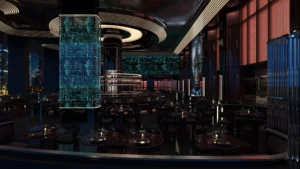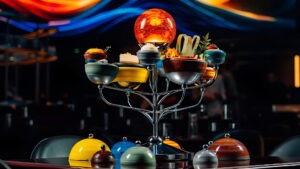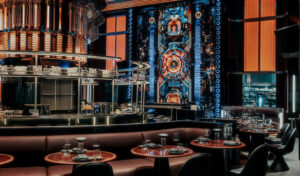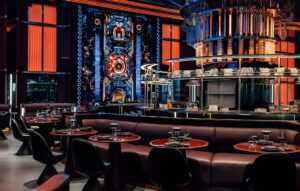Fine dining has always thrived on the dialogue between artistry and technique. At WOOHOO in Dubai, that dialogue now includes a third voice: artificial intelligence. The restaurant’s collaboration with Chef Aiman—positioned as the world’s first AI-driven chef concept—offers a rare, behind-the-pass look at how algorithms, data, and human intuition can co-create a tasting menu that feels both futuristic and deeply personal. This deep dive traces Chef Aiman’s creative process from the moment a dish is conceived to the instant it reaches the table, and explores how AI quietly reshapes sourcing, prep, service, and guest feedback loops without stealing the spotlight from the pleasures of the plate.
Key Takeaways:
- WOOHOO’s AI-forward concept centers on Chef Aiman, who blends technology with culinary art to design inventive Japanese–Peruvian–Mexican tasting experiences.
- AI augments—not replaces—culinary creativity: it analyzes flavor networks, seasonal data, and guest preferences to accelerate ideation and refine recipes.
- The Spock Lounge and other immersive elements demonstrate how thoughtful tech elevates private dining, personalization, and hospitality.
What Makes WOOHOO’s Concept Different?
Located in Downtown Dubai at the Kempinski The Boulevard Hotel, WOOHOO treats technology as a mise en place for imagination rather than a gimmick. Guests encounter interactive menus, ambient lighting that subtly follows the rhythm of service, and real-time kitchen visuals that bring transparency to craft. Yet the core of the experience remains culinary: a carefully paced progression of courses that traverse Japanese precision, Peruvian brightness, and Mexican warmth. By design, the technology is there to deepen context and connection, not to distract. For readers who want more background on the tools involved, our primer on machine learning fundamentals provides helpful orientation, and our overview of artificial intelligence covers the broader concepts at play.
Inside Chef Aiman’s Creative Process
When a new dish begins, the first step is not chopping but mapping. Chef Aiman partners with an AI system that maintains a large “flavor graph”—a network model linking ingredients by shared aroma compounds, historical pairings, regional uses, and guest sentiment. The model ingests structured data such as seasonality calendars, supplier freshness scores, and cost curves, along with unstructured signals like tasting notes, post-service debriefs, and anonymized feedback from past diners. This gradually forms the creative brief for each course.
Step 1: Ideation With Constraints
Great food rarely emerges from infinite choice; it thrives within constraints. Chef Aiman sets parameters: an ingredient to spotlight, a cultural reference, a textural goal, a temperature, a dietary boundary, and a target emotional arc (e.g., “spark curiosity,” “clean reset,” or “lingering comfort”). The AI proposes 6–12 candidate pathways—mini storylines that might, for instance, push a lime–yuzu acidity toward a smoky, fermented counterpoint, or temper miso depth with the floral lift of huacatay. Each pathway is scored against constraints such as sourcing feasibility and carbon impact, aligning with WOOHOO’s commitment to mindful procurement (see our take on customer experience and how sustainability strengthens hospitality value).
Step 2: Sensory Simulation and Pairing Logic
The system then simulates mouthfeel and volatile compound release at different temperatures and cuts. For example, it may suggest a tight julienne of shiso to release aroma faster at the table, or a specific resting time for cedar-smoked scallops to harmonize with aji amarillo heat. It flags potential clashes (say, too many phenolic notes competing in a single bite) and recommends balancing elements: a lactic crema for warmth or a kosho gel to add clean, saline brightness. To learn how pairing decisions are formalized, our explainer on AI in hospitality dives into data-informed taste profiling.
Step 3: Rapid Prototyping and Micro-Iterations
In the test kitchen, A/B tasting is the norm. Two or three micro-variations are plated with small deltas—0.2% salt swing, 3°C difference in confit oil, or an alternate pickling brine. The AI records structured tasters’ feedback and correlates it with measurable outcomes (plate-back time, leftover ratios, and palate fatigue markers during longer menus). Within an afternoon, the team may run 20+ cycles, allowing human judgment to decide between two “correct” answers. Here, AI accelerates the narrowing funnel; the final leap—the decision that defines a dish’s soul—belongs to the chef.
Step 4: Plating as Information Design
Plating is treated like a choreography where visual hierarchy, bite flow, and utensil path matter. The model proposes component placement based on average right-handed diner movement, aroma plumes, and temperature stability. It might recommend, for instance, positioning a chilled leche de tigre sphere slightly windward of a warm tostada so the citrus nose arrives first, followed by toasted corn warmth. Edits occur in real time as Chef Aiman evaluates how story, culture, and texture interlock. This is where the intangible—nostalgia, humor, a reference to street food—enters the plate.
From Market to Menu: Sourcing With Foresight
WOOHOO’s inventory engine forecasts demand using reservation patterns, macro events in Dubai, and seasonality. It alerts the team when a rare mackerel run peaks or when a specific chili harvest lands with above-average capsaicin variance. Waste reduction is a creative prompt, not merely an operational metric: stems, peels, and trimmings inspire infusions and garnishes that become signatures in their own right. Guests curious about the data side of this practice can browse our overview of AI ethics, which touches on responsible data use and environmental considerations.
How AI Shapes the Guest Journey
Personalization at WOOHOO is respectful and unobtrusive. With permission, the system remembers macro preferences—capsicum sensitivity, spice tolerance, ethanol avoidance, shellfish allergies—and suggests configurations that fit the evening’s tasting arc. If a guest loved a prior kombu-cured tuna but now follows a plant-forward regimen, the recommendation engine pivots: perhaps a hibiscus-cured daikon layered with avocado–miso crema and a charred corn relish appears as a spiritual cousin. For broader context on personalization frameworks, see our guide to designing customer experiences.
Immersive Service Touchpoints
Interactive tables let guests explore ingredients, producers, and preparation notes at their own pace, while a subtle live feed from the pass builds anticipation without breaking the fourth wall. Ambient light temperature shifts in step with service to keep colors natural and eyes relaxed. A private debrief after dessert translates reactions into learning signals for the next menu cycle. Privacy is paramount: data is anonymized, minimized, and retained only as long as necessary—principles we expand on in our discussion of data privacy.
The Fusion Core: Japanese–Peruvian–Mexican
WOOHOO’s culinary identity pulls threads from three vibrant traditions. From Japan: knife work, temperature control, and a reverence for clarity. From Peru: the citrus-and-chili grammar of cevichería culture, the earthiness of Andean tubers, and bold herbaceous notes. From Mexico: masa, smoke, and the confidence to place acidity and heat at the center of the bite. AI acts as an ethnographer and librarian, surfacing historical contexts and preventing reductive mashups. Instead of a “greatest hits” collage, dishes become precise dialogues—yuzu and lime negotiate with aji amarillo; ponzu meets piloncillo in a glaze that’s bright and caramel-warm rather than cloying.
Example Dish: Yuzu Leche Tostada
A crisp blue-corn tostada carries a layer of yuzu-leche de tigre gel, topped with torched hamachi, a whisper of chipotle oil, and shaved fennel marinated in rice vinegar. The AI flagged this construct for volatile harmony (citrus, smoke, anise) and suggested micro-doses of sesame to add roasted bass notes. Final seasoning is manual; Chef Aiman finishes with flaky salt and an herb dust anchored by huacatay.
Example Dish: Wagyu Anticucho With Miso-Tamarind
A thin slab of wagyu is brushed with a miso–tamarind reduction, skewered, and licked by charcoal. The sauce’s glutamates meet tamarind’s tart-sweet pull; aji panca adds deep warmth. An AI-derived resting window of 90 seconds preserves peak juiciness for the walk from grill to guest. The garnish—shaved daikon tossed in lime zest and togarashi—was a human-instinct addition that made the dish sing.
The Spock Lounge: Private Dining, Amplified
For intimate gatherings, the Spock Lounge provides an environment tuned to conversation and discovery. Augmented reality previews let guests visualize portion scales or swap garnishes before committing. The system can calibrate pacing to the room’s energy—slowing between heavy conversations, advancing when glasses are empty, gently coordinating wine service with the arrival of high-aroma courses. Because tech should be invisible when hospitality is visible, the interface recedes once choices are made. If you’re exploring the enabling tools behind these experiences, our overview of augmented reality offers a deeper look at how AR supports storytelling.
Collaboration, Not Replacement
It’s crucial to understand that AI is a collaborator. In mise en place, it predicts prep volumes; during service, it helps sequence fire times when multiple tables converge; after hours, it parses notes into next-day experiments. But it cannot taste, smell, or perceive context the way a human can. The instinct to season “until it feels right,” to pull a scallop ten seconds early because the muscle tells you so—that remains human. The magic of WOOHOO is that computational speed and human feeling are given equal dignity.
Operational Wins That Protect Creativity
Behind the scenes, forecasting keeps the pantry lean and fresh. Batch sauces are logged with pH and temperature profiles; AI alerts chefs if a variance could threaten flavor stability or food safety. Equipment maintenance is predictive, reducing mid-service surprises. These guardrails free the brigade to spend more time on creativity—exactly where fine dining should invest its hours. For a broader industry view, our feature on AI in hospitality explains how these efficiencies enhance—not diminish—the craft of service.
Guest Reactions and Learning Loops
Most diners remark first on the clarity of flavors: dishes taste focused, not busy. Interactive elements feel helpful rather than flashy; guests appreciate being able to peek into technique without a masterclass interrupting conversation. The strongest praise, however, targets the narrative coherence of the meal—the sense that each course knows its role in the story. When feedback is offered, it is translated into practical experiments for the next cycle. Over time, the system builds a nuanced palate profile for the restaurant itself, capturing WOOHOO’s evolving identity.
Market Position: Where WOOHOO Fits
As more restaurants experiment with digital tools, WOOHOO distinguishes itself by letting tech play a supporting role in a chef-led performance. The concept neither fetishizes machines nor denigrates them; it treats AI as a new set of knives—powerful, precise, and only as meaningful as the hand that wields them. For readers tracking the evolution of the space, our continuing coverage on AI and hospitality trends highlights how guest expectations are shifting in favor of personalization, transparency, and sustainability.
What’s Next for AI-Assisted Fine Dining?
Looking ahead, expect richer ingredient telemetry—think micro-farm data streaming directly into the flavor graph—plus better non-alcoholic pairing models that treat botanicals with the same rigor as wine. Multisensory integrations may grow more nuanced, with soundscapes micro-tuned to course tempo rather than broad playlists. Ethical frameworks around data minimization and consent will take center stage; you can explore our perspective in AI ethics for hospitality. The guiding principle will remain constant: use technology to make hospitality feel more human, not less.
Frequently Asked Questions
1) How exactly does AI help Chef Aiman create new dishes?
AI proposes ingredient relationships, predicts balance points for acid–fat–salt, and simulates how temperature and cut affect aroma release. It narrows options quickly, so hands-on tasting can focus on the few most promising directions. The final call is always culinary, not computational.
2) Does AI write the menu?
AI drafts possibilities and constraints; the chef writes the menu. Language, cultural references, pacing, and the emotional arc of the meal are authored by humans drawing on memory, curiosity, and craft.
3) Will every guest get a different menu?
Not necessarily. Personalization is used where it adds joy or safety (allergies, aversions, macro preferences). Otherwise, guests share a seasonally evolving tasting journey. The goal is coherence, not novelty for novelty’s sake.
4) How does WOOHOO protect guest data?
Consent, minimization, and anonymization. Only essential preference data is retained, for limited periods, and guests can opt out at any time. Learn more in our overview of privacy-by-design in hospitality.
5) Can technology replace the chef?
No. Technology can accelerate analysis and logistics; it cannot replace taste memory, cultural sensibility, or the human capacity to delight. At WOOHOO, AI is a collaborator that makes room for more creativity, not a substitute for it.
6) How can I learn more or get in touch?
For inquiries about AI-led experiences, partnerships, or coverage, please reach out via our contact page. If you’re new to the topic, our guides on AI basics and AI in hospitality are helpful starting points.





